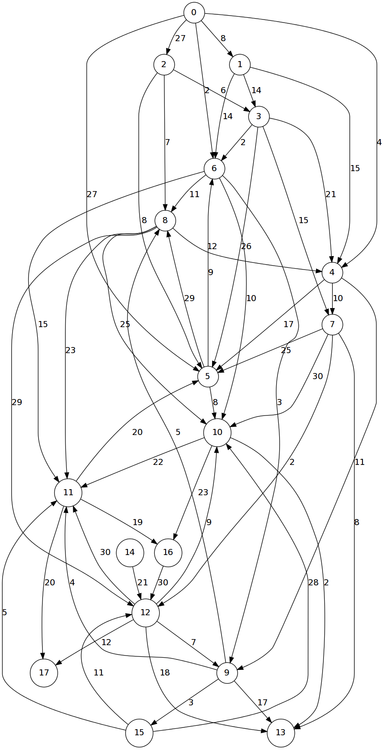An Implementation of Ford-Fulkerson Algorithm in Common Lisp
Description of the problem
Given a network where edges have predetermined capacities, our task is to determine the maximum possible flow between any two vertices in the network.
One possible solution is to use Ford-Fulkerson Algorithm. Today, I am going to implement Ford-Fulkerson in lisp.
Flow networks
I am going to represent the graphs as pairs of vertices and a number representing the capacity in that particular direction. For example
(defvar G '(((0 1) . 3) ((1 2) . 1) ((1 3) . 1) ((2 4) . 2)
((3 4) . 1) ((4 5) . 0) ((3 5) . 3) ((2 5) . 2)
((5 6) . 1)))
Grepresents

Finding a path
In order to implement the algorithm we are going to need find paths from the source to the sink. The function below will find such a path using a depth-first search.
(defun find-a-route (x y G &optional (past (list x)))
(let* ((res nil)
(neigh (dolist (i G (reverse res))
(if (and (> (cdr i) 0) (= x (caar i)))
(push (cadar i) res))))
(next (set-difference neigh past)))
(cond ((null next) nil)
((member y next) (reverse (push y past)))
(t (some (lambda (i) (find-a-route i y G (cons i past))) next)))))
FIND-A-ROUTEAugmented flow
Next, we need to find the maximum flow which is the minimum capacity on the path
(defun max-flow (path capacity)
(let ((res (mapcar (lambda (x y) (cdr (assoc (list x y) capacity :test #'equal)))
path
(cdr path))))
(and res (apply #'min res))))
MAX-FLOWThe Ford-Fulkerson algorithm implemented
And finally here is an implementation of the Ford-Fulkerson maximum flow algorithm. Along each augmented path, we increase the flow and decrease the capacity. If there was a flow in the reverse direction, we also decrease that too, and on top of that, on the capacity network we add a reverse flow on such edges.
(defun ford-fulkerson (a b network)
(let ((capacity (copy-list network))
(flow (mapcar (lambda (x) (cons (car x) 0)) network)))
(labels ((modify (edge net val)
(incf (cdr (assoc edge net :test #'equal)) val))
(augment (path)
(let ((m (max-flow path capacity)))
(dolist (edge (mapcar #'list path (cdr path)))
(if (assoc edge flow :test #'equal)
(progn (modify edge flow m)
(modify edge capacity (- m)))
(progn (modify (reverse edge) flow (- m))
(if (assoc edge capacity)
(modify edge capacity m)
(push (cons edge m) capacity))))))))
(do ((path (find-a-route a b capacity) (find-a-route a b capacity)))
((null path) flow)
(augment path)))))
FORD-FULKERSONSome tests
To test the algorithm I am going to need a random flow network. The following function will give us such a random flow network.
(defun random-graph (n m k)
(remove-duplicates
(loop for i from 0 to n append
(loop repeat m collect
(if (zerop (random 8))
(cons (list (+ i 1 (random m)) i) (1+ (random k)))
(cons (list i (+ i 1 (random m))) (1+ (random k))))))
:test (lambda (x y) (or (equal (car x) (car y))
(equal (reverse (car x)) (car y))))))
RANDOM-GRAPHSo, here is a random flow network:
(defvar a-random-flow (random-graph 12 6 30))
A-RANDOM-FLOW
Let us find some random paths between points:
(find-a-route 0 13 a-random-flow)
(0 2 5 8 12 13)Let us see if we get the right maximum flow:
(max-flow (find-a-route 0 13 a-random-flow) a-random-flow)
8Let us test on our small network we defined at the very beginning:

And, now on the large random network I defined above:
(defvar flow (ford-fulkerson 0 13 a-random-flow))
FLOW